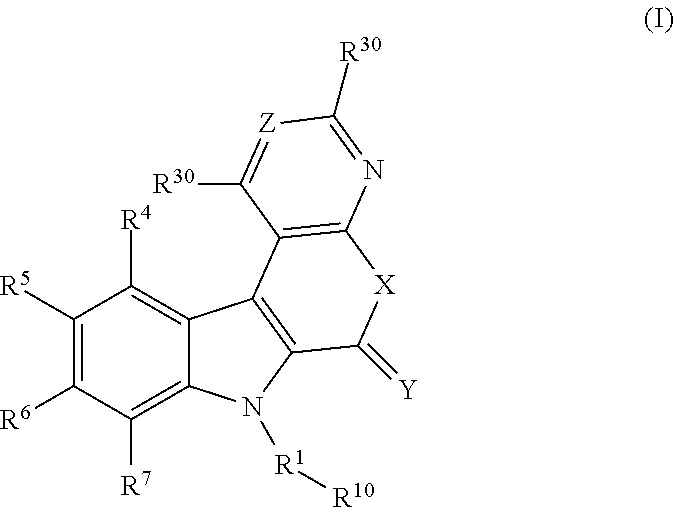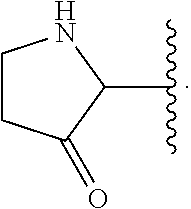Tetracyclic indole derivatives and their use for treating or preventing viral infections
- Summary
- Abstract
- Description
- Claims
- Application Information
AI Technical Summary
Benefits of technology
Problems solved by technology
Method used
Image
Examples
example 1
Preparation of Intermediate Compound 1E
[0379]
Step 1:
[0380]
[0381]To a solution of ethyl 5-chloroindole-2-carboxylate, 1A (20 g, 89.6 mmol) in THF (200 mL) in a cooled water bath was added N-bromosuccinimide (16.0 g, 89.9 mmol) slowly. The resulting reaction mixture was stirred at room temperature for 18 h before water (700 mL) was added. The mixture was continued to stir at room temperature for 20 min and then filtered. The solids were washed with water (2×100 mL), and dried to afford the crude product 1B (25.8 g, 90% yield). 1H NMR (500 MHz, CDCl3) δ 9.06 (s, 1H), 7.66-7.65 (m, 1H), 7.35-7.31 (m, 2H), 4.47 (q, J=7.25 Hz, 2H), 1.46 (t, J=7.09 Hz, 3H).
Step 2:
[0382]
[0383]To a mixture of 3-bromo-5-chloro-1H-indole-2-carboxylic acid ethyl ester, 1B (1.00 g, 3.31 mmol), 2,4-dimethoxypyrimidine-5-boronic acid (0.73 g, 3.97 mmol), [1,1′-bis(diphenylphosphino)ferrocene]dichloropalladium(II) with dichloromethane complex (1:1) (0.26 g, 0.32 mmol) in DME (15 mL) was added a solution of sodium c...
example 2
Preparation of Intermediate Compound 2E
[0388]
Step 1:
[0389]
[0390]To a solution of 5-chloro-1H-indole-2-carboxylic acid ethyl ester, 2A (5.0 g, 22 mmol) in chloroform (25 mL) at room temperature was added N-iodosuccinimide (5.0 g, 22 mmol). The resulting suspension was stirred at room temperature for 24 h. The mixture was then concentrated under reduced pressure, and the residue dissolved into ethyl acetate (300 mL). The mixture was washed with water (100 mL) and brine respectively. The separated organic layer was dried over sodium sulfate, filtered and concentrated under reduced pressure to give the crude product 2B (7.0 g, 91% yield). M.S. found for C11H9ClINO2: 350.2 (M+H)+.
Step 2:
[0391]
[0392]5-Chloro-3-iodo-1H-indole-2-carboxylic acid ethyl ester, 2B (3.0 g, 8.6 mmol) was dissolved into 1,2-dimethoxyethane (40 mL) and PdCl2(dppf)2 (0.7 g, 0.86 mmol) was added. The resulting mixture was refluxed at 90° C. for 0.5 h. To the above mixture was added slowly a solution of 2-methoxy-3-py...
example 3
Preparation of Intermediate Compound 3E
[0397]
Step 1:
[0398]
[0399]Ethyl 5-bromo 2-indole carboxylate, 3A (4.0 g, 14.9 mmol) was dissolved into acetone (200 mL) at room temperature. To the mixture was added N-iodosuccinimide (3.65 g, 15.4 mmol). The resulting suspension was stirred at room temperature for 3 h. The mixture was concentrated under reduced pressure, and the residue was dissovled into ethyl acetate (150 mL). The mixture was washed with saturated aqueous sodium thiosulfate solution (50 mL). The layers were separated, and the aqueous layer was extracted with ethyl acetate (2×100 mL). The combined organic layer was dried (magnesium sulfate), filtered and concentrated under reduced pressure to give the crude product 3B (100% yield). 1NMR (400 MHz, d6-DMSO): δ 12.48 (s, 1H), 7.55 (s, 1H), 7.45-7.44 (m, 2H), 4.39 (q, J=6.59 & 7.32 Hz, 2H), 1.38 (t, J=7.32 Hz, 3H).
Step 2:
[0400]
[0401]5-Bromo-3-iodo-1H-indole-2-carboxylic acid ethyl ester, 3B (8.66 g, 21.9 mmol) was dissolved into 1...
PUM
| Property | Measurement | Unit |
|---|---|---|
| Pharmaceutically acceptable | aaaaa | aaaaa |
Abstract
Description
Claims
Application Information
 Login to View More
Login to View More - R&D
- Intellectual Property
- Life Sciences
- Materials
- Tech Scout
- Unparalleled Data Quality
- Higher Quality Content
- 60% Fewer Hallucinations
Browse by: Latest US Patents, China's latest patents, Technical Efficacy Thesaurus, Application Domain, Technology Topic, Popular Technical Reports.
© 2025 PatSnap. All rights reserved.Legal|Privacy policy|Modern Slavery Act Transparency Statement|Sitemap|About US| Contact US: help@patsnap.com



